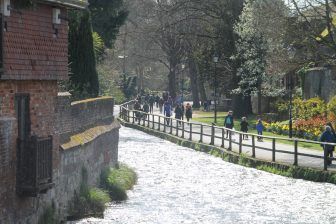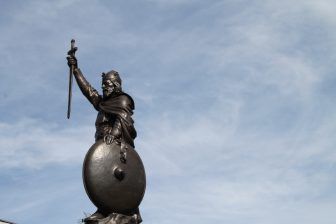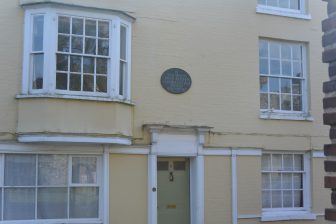
[ Mar.2017 ] To walk around Winchester, the historical city in the south of England where we went just for a day from London, we needed a map, so we went to the tourist office.
The staff who gave us the map said “Would you like to join the walking tour starting at 2 o’clock?”.
It was 5 minutes to 2 and the fee was only £5 per person, so we decided to do that.
The guide was called Judith and she was from York in north England.
About 10 people joined the tour.
First she took us to the park from where we could see a huge statue and started explaining the origin of the city.
The native people here accepted the Romans peacefully.
The Romans reclaimed the land from the estuary of the Itchen river; they made the river flow only in the current place and developed the surrounding area.
The statue we saw was Alfred, who ruled here after the Roman’s left, fought against the Vikings and stopped them invading the land.
The statue itself was erected in 1901 in commemoration of 1000 years after his death.
Apparently when they placed the huge statue on the base, they used sugar to slide it.

To learn this kind of trivia is the pleasure of tours.
Then we moved to the path along the River Itchen.
In this region, the land is made of chalk and the flint which is found with the chalk is used as the building material here.
Around the 10th century, the Bishop of Winchester had a huge diocese and great power and he was very wealthy because of the income from the market which he restricted to only one place, on the hill near the city.
In those days, his diocese was spread from the south bank of River Thames in London to the seaside in the south.
In Winchester, there is a prestigious public school, Winchester College, founded in 1387.
The Bishop started this college because many skills were lost by the Black Death which killed a lot of people between 1348 and 1351, and he strongly believed that people needed education.
Currently it is still a boys only college, but they do not have any pretty uniforms like Eton or Harrow colleges.
The 8 -13 year old pupils of the prep school called The Pilgrim’s School are the members of the choir for the chapel of the college and also for the cathedral.
And interestingly the colours of the uniform for the pupils are decided according to where they sing i.e. the boys who sing in the college chapel wear red uniforms, the ones who sing at the cathedral wear blue and the ones who do not sing wear green.
We also learned about Jane Austen, the author.
Originally she did not live in the city, but when she became ill she moved here with her sister called Cassandra.
We saw the house where she spent her last 6 weeks.
She died in 1817 and they are still not sure what illness she had.
Some say it was Addison’s disease.
Her body was buried in the cathedral.
Anyway, there was much more during our 1 and a half hours’ walking tour.
It was very nice day with a lot of blooming blossoms, so it was really a pleasant walk.





